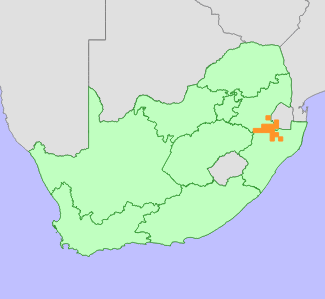|
Scientific Name | Aloe hlangapies Groenew. |
Higher Classification | Monocotyledons |
Family | ASPHODELACEAE |
National Status |
Status and Criteria | Vulnerable B1ab(iii) |
Assessment Date | 2019/03/13 |
Assessor(s) | H. Mtshali |
Justification | Aloe hlangapies has a restricted distribution range (extent of occurrence 10 783 km²), and the population has been severely fragmented due to 40% habitat loss to timber plantations and agriculture. It continues to decline due to ongoing habitat loss and degradation. |
Distribution |
Endemism | Not endemic to South Africa |
Provincial distribution | KwaZulu-Natal, Mpumalanga |
Range | This species is endemic to a small area in southern Mpumalanga and northern KwaZulu-Natal, South Africa, extending to south-western Swaziland. |
Habitat and Ecology |
Major system | Terrestrial |
Major habitats | KaNgwane Montane Grassland, Wakkerstroom Montane Grassland, Northern Zululand Mistbelt Grassland, Paulpietersburg Moist Grassland, Northern KwaZulu-Natal Moist Grassland, Low Escarpment Moist Grassland |
Description | It occurs most frequently in rocky outcrops in grassland, as well as on road cuttings. It likely also occurred in open grasslands near drainage lines and seeps in the past, but most of this type of habitat within its distribution range has been lost or degraded. |
Threats |
| About 40% of the grassland habitat of A. hlangapies has been lost to timber plantations, crop fields and infrastructure development, and loss is ongoing. Remaining grasslands in the Piet Retief to Vryheid areas are heavily grazed, which has led to a loss of species diversity, particularly forb species (L. von Staden pers. obs.). The result is that species such as A. hlangapies persist mainly in road verges and other small grassland fragments where grazing is excluded or pressure is low (Craib 2005).
Dense infestations of alien invasive plants, particularly wattles (Acacia mearnsii) has been observed in the habitat of A. hlangapies, particularly in the area between Dirkiesdorp and Wakkerstroom (Craib 2005). Habitat loss and degradation due to coal mining is also a potentially severe threat to this species, with court battles to prevent mining inside a protected area ongoing. |
Population |
Aloe hlangapies occurs in scattered, small groups of plants in small areas of habitat between timber plantations and in road reserves (Craib 2005), and therefore the population is considered severely fragmented. At many localities where the species is known through historical records, the habitat has been extensively degraded and transformed, and it is likely to be locally extinct in many of these places, although field surveys are needed to confirm this. It has been recently recorded at 11 locations, mainly around Wakkerstroom. A continuing population decline is inferred from ongoing habitat loss and degradation.
|
Population trend | Decreasing |
Notes |
| Aloe hlangapies was reduced to synonymy under A. ecklonis by Glen and Hardy (2000) in their revision of genus Aloe. However, the species concept as proposed by Reynolds is upheld since the two species flower in different seasons. A. hlangapies flowers from mid-October to mid-November, and A. ecklonis mostly in late November and December in areas where A. hlangapies also occurs.
Aloe hlangapies differs from A. ecklonis by having distichous leaves. This character is not constant, however, and some plants of A. hlangapies have rosulate leaves. The leaves and the densely capitate racemes of apricot-coloured flowers are the main characters distinguishing A. hlangapies from A. ecklonis (Craib 2005). |
Assessment History |
Taxon assessed |
Status and Criteria |
Citation/Red List version | | Aloe hlangapies Groenew. | Lower Risk - Least Concern | Scott-Shaw (1999) | | Aloe hlangapies Groenew. | Not Threatened | Hilton-Taylor (1996) | |
Bibliography |
Craib, C. 2005. Grass Aloes in the South African Veld. Umdaus Press, Hatfield.
Reynolds, G.W. 1969. The Aloes of South Africa. A.A. Balkema, Cape Town.
Van Wyk, B.-E. and Smith, G. 2003. Guide to aloes of South Africa. (2nd ed.). Briza Publications, Pretoria.
|
Citation |
| Mtshali, H. 2019. Aloe hlangapies Groenew. National Assessment: Red List of South African Plants version 2024.1. Accessed on 2025/12/23 |
 Comment on this assessment
Comment on this assessment

